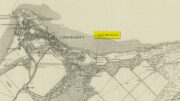Legendary Rock: OS Grid Reference – NH 7949 6746
Also Known as:
- Clach Mallach
- Clach na Mallachd
- Clackmalloch Rock
- Stone of Cursing
Archaeology & History

This large boulder found off the Cromarty coast, was highlighted on the 1880 OS-map of the region. It is one of the ancient boundary stones of the township.
Folklore
We know from the vast array on the folklore of stones that many were imbued with magickal abilities, some of which were witnesses to vows and others to make curses from. This large boulder off the coast of Cromarty was, according to Donald MacKenzie (1935), a place where the latter used to be done. He told us:
“At Cromarty there is a big boulder known as the Clach na Mallachd (‘Stone of Cursing’). Curses were delivered when an individual stood or knelt bare-kneed upon it.”
In an earlier account by the Ordnance Survey lads in one of their Name Books, they gave the following tale that had been narrated to them:
“A large stone Situate at the Low Water, and forming one of the boundary Stones of the burgh, the reason of its having this name is, that a young lad while Sitting on it was overwhelmed by the advancing tide and drowned, his mother when told of it, cursed the stone, hence the name Clach Mallach (Accursed Stone)”
References:
- MacKenzie, Donald A., Scottish Folk-lore and Folk Life, Blackie: Glasgow 1935.
© Paul Bennett, The Northern Antiquarian
The map could not be loaded. Please contact the site owner.
